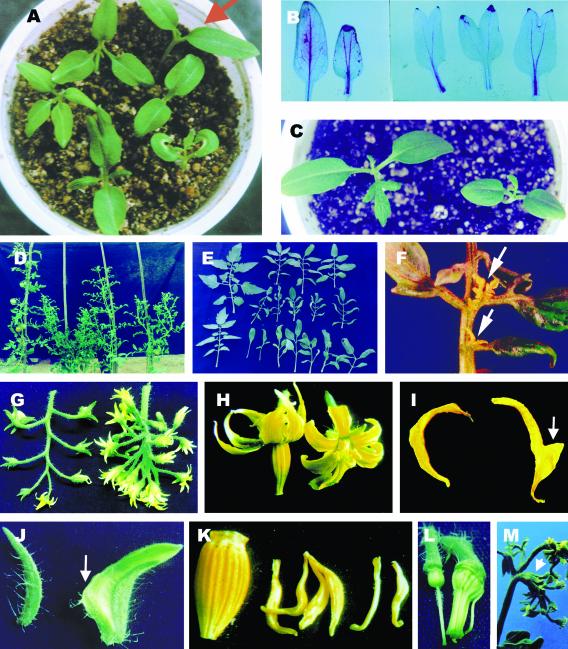Figure 1.
Morphology of poc plants throughout life cycle. A, poc seedlings (clockwise from top right): wild-type seedlings (arrow); dicot [1+(2)], note two midveins; dicot with two halves of curled cotyledons; dicot [1+(2)] with a partially fused cotyledon; tetracot; and tricot. B, Fused poc cotyledons showing two midveins running parallel in the petiole. Wild type (left). C, poc dicot seedling showing smaller and more rounded cotyledons. Wild type (left). D, Phenotype of 3.5-month-old plants. Wild type (left), poc A (second from left), poc B (third from left), poc C (right). E, Adult leaves (sixth node onwards) of 3-month-old wild type and poc mutant. In poc mutant, the leaf abnormalities vary from the simple lanceolate leaf to leaf with variable number of leaflets, reduction in size, and loss of lobing in leaflets. Wild type (upper and lower left), poc B (upper row), poc A (middle row), poc C (lower row). Wild-type leaves (upper and lower left). F, Epiphyllous structures (arrows) on poc leaves appearing near the junction of petiolule to the rachis. G, poc inflorescence (right) showing multiple blooming flowers with abnormal phyllotactic arrangement. H, poc flower (right) showing the absence of anther cone and shorter petals. I, poc petal (right) with an appendage on stamen-facing side (arrow). J, poc sepal (right) with a petal-like sector. Note the absence of trichomes (arrow). K, Twisted and short stamens of poc mutant lacking fusion to form anther cone. Wild type (left). L, Fusion of stamens of poc to the carpel. M, Appearance of a new inflorescence from inside of a fully differentiated flower of poc mutant (arrow).

